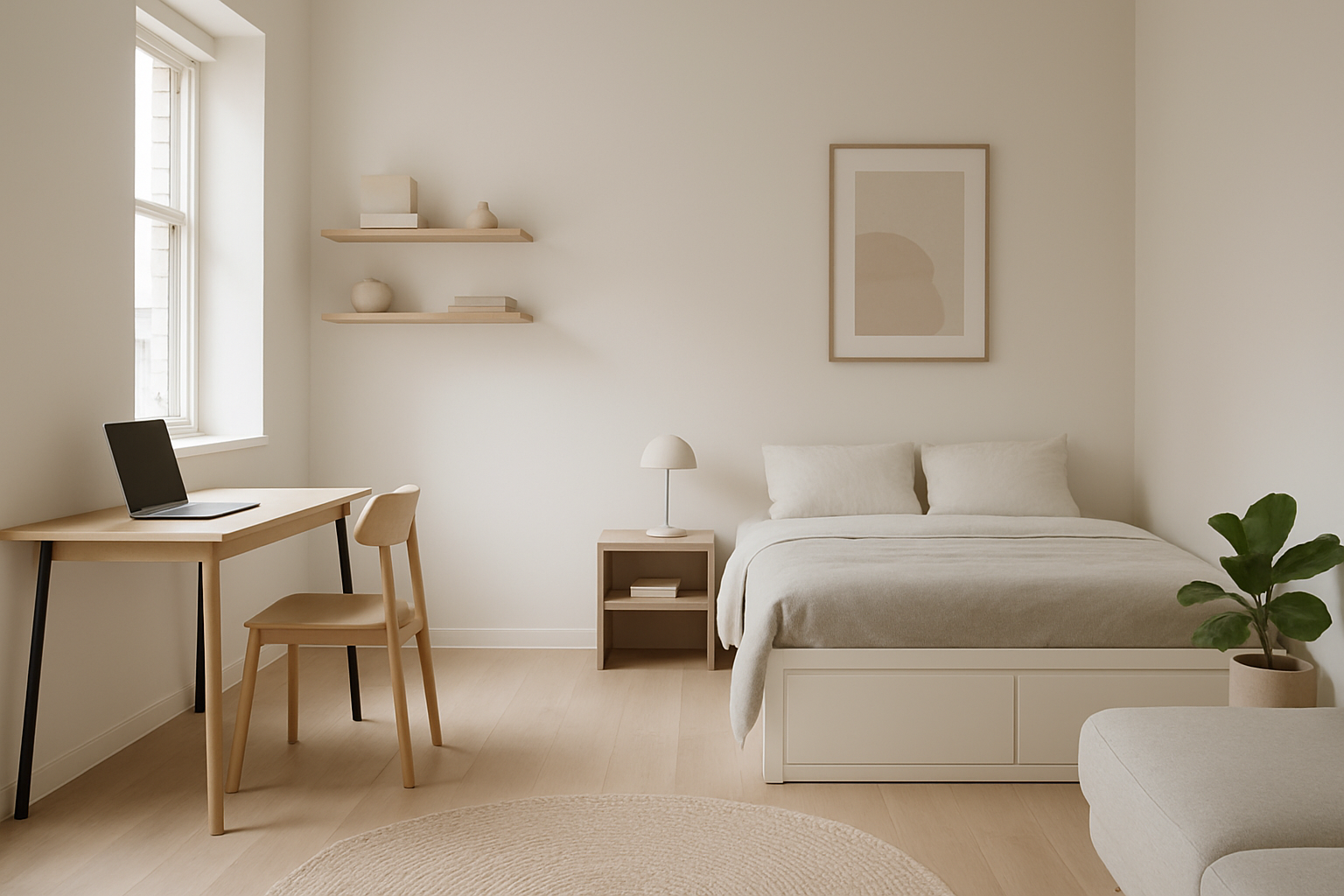In the world of interior design, minimalism isn’t just a trend—it’s a practical solution for small apartments, especially when your living space also serves as your workspace. A minimalist design can make a small apartment feel open, calm, and organized, while also improving your productivity and mental clarity.
This article will guide you through the principles of minimalist design and how to apply them to decorate a small apartment with a home office, creating a beautiful and functional space that feels larger than it is.
What Is Minimalist Interior Design?
Minimalist design is rooted in the concept of “less is more.” It focuses on:
- Simplicity
- Functionality
- Clean lines
- A limited color palette
- Decluttered spaces
It doesn’t mean your home has to be cold or boring. In fact, minimalist spaces can feel warm, comfortable, and deeply personal when done correctly.
Why Minimalism Works for Small Apartments
Small spaces can quickly become overwhelming when filled with too many things. Minimalist design counters this by encouraging intention in every choice.
Benefits include:
- Visually larger rooms
- Easier cleaning and maintenance
- Improved organization
- Better mental focus, especially for home offices
Minimalism also allows you to highlight quality over quantity, so you invest in fewer, better items that truly serve your needs.
Step-by-Step Guide to Applying Minimalism in Small Apartments
Let’s break down how to achieve a minimalist design that enhances both living and working spaces in your small apartment.
1. Declutter Before You Decorate
The foundation of minimalism is reducing unnecessary possessions. Start by assessing each item in your apartment.
Tips:
- Keep only what you use or love.
- Remove duplicates or items that no longer serve a purpose.
- Organize belongings into three categories: keep, donate, discard.
Decluttering instantly creates more space and mental clarity.
2. Stick to a Neutral Color PaletteMinimalist interiors typically use neutral and earthy tones that create a calm, cohesive environment. These colors reflect light and help open up the space.
Recommended colors:
- White
- Soft gray
- Beige
- Taupe
- Light wood tones
For accents, use muted tones like sage green, soft navy, or charcoal black.
3. Invest in Multi-Functional, Simple Furniture
Furniture in minimalist spaces is streamlined and practical. Each piece should have a clear purpose—and, ideally, more than one function.
Great minimalist furniture ideas:
- A desk that doubles as a dining table
- A bed with under-storage drawers
- A storage ottoman that works as extra seating
- A wall-mounted desk for a floating effect
Choose items with clean lines, no ornate details, and in neutral finishes like wood, white, or black.
4. Create a Dedicated Home Office NookEven in a small apartment, you can integrate a home office in a minimalist way.
How to keep it clean and focused:
- Choose a compact desk or wall-mounted fold-down table.
- Use floating shelves for vertical storage.
- Hide clutter with concealed drawers or boxes.
- Select a minimalist desk lamp and wireless keyboard/mouse to reduce visual noise.
Position your desk near a window if possible to bring in natural light.
5. Maximize Natural Light
Lighting is key in small minimalist spaces. Natural light enhances the feeling of openness and eliminates the need for bulky lighting.
Tips:
- Use sheer curtains or blinds that don’t block light.
- Position mirrors across from windows to reflect light.
- Opt for low-profile floor and table lamps with soft, warm lighting.
Keep your windows clean and clear for maximum effect.
6. Decorate with Intention
In minimalism, every decorative element should serve a purpose—either functional or emotional.
Less is more:
- A single piece of art instead of a gallery wall
- A small indoor plant for a touch of life and color
- One or two cushions in natural fabrics
- Neutral ceramics or wooden trays
Avoid overly patterned rugs or bright color splashes. Stick to your palette and repeat textures and tones for harmony.
7. Use Open Space as a Design ElementEmpty space is just as important as filled space in minimalist design. Don’t be afraid to leave walls blank or let surfaces stay clear.
Space tips:
- Leave gaps between furniture for easy movement.
- Don’t overcrowd bookshelves—leave breathing room between items.
- Use rugs and lighting to define areas without physical dividers.
This openness creates a peaceful atmosphere and improves functionality.
8. Choose Hidden or Vertical StorageTo maintain a minimalist look, you need storage that hides clutter while still being accessible.
Smart storage ideas:
- Floating wall shelves with concealed boxes
- Closed cabinets under desks or TV stands
- Under-bed storage bins or drawers
- Hooks behind doors for bags, jackets, or headphones
Avoid open baskets filled with random items—these easily become visual clutter.
9. Go Digital Where Possible
One way to reduce clutter in a minimalist home office is to digitize your workspace.
Ideas:
- Use cloud storage instead of paper files
- Replace physical notebooks with tablets or apps
- Scan important documents and discard physical copies
- Limit physical office supplies to the absolute essentials
Digital living keeps your space free from unnecessary piles and paperwork.
10. Maintain a Minimalist Mindset
Minimalism is not a one-time setup—it’s a lifestyle. To make it sustainable:
- Review your space regularly to eliminate things that creep back in.
- Be intentional with every new item you bring into your home.
- Ask yourself, “Do I really need this?” before purchasing.
- Create a “one in, one out” rule to avoid buildup.
This mindset keeps your home peaceful, organized, and functional long-term.
Final Thoughts: A Bigger Life in a Smaller SpaceMinimalist design is the perfect strategy for making small apartments feel open, elegant, and efficient. When you eliminate excess, you create room for what really matters—comfort, focus, and intentional living.
By choosing neutral colors, multipurpose furniture, and a decluttered layout, you’ll enjoy a home that’s both beautiful and highly functional. And when you apply these principles to your home office as well, you’ll be more productive and less stressed.
In a world full of distractions and chaos, a minimalist space is a sanctuary of clarity. Your apartment may be small—but with minimalism, your lifestyle can be expansive.

